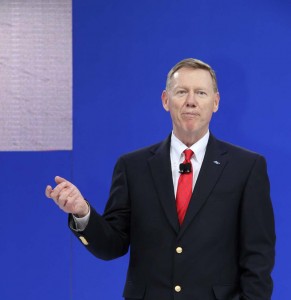Investors are showing a restrained reaction to word that Ford Motor Co. will restore its dividend for the first time in five years – a less than desirable outcome for the automaker’s senior management team who’d hoped that the nickel-a-share dividend would help drive up the Ford stock price.
With 4 billion shares of stock outstanding, the restoration of the Ford dividend is a nonetheless significant increase in its quarterly costs, totaling about $800 million annually, or $200 million every three months. Nonetheless, Ford officials have expressed hope, in recent months, that the restoration of the dividend would be a critical step in their goal of both boosting the maker’s stock – and helping it regain a much-sought investment grade credit rating.
“We have made tremendous progress in reducing debt and generating consistent positive earnings and cash flow,” Executive Chairman Bill Ford said in a press release announcing the dividend payment, which will be issued next March 1.
The great-grandson of company founder Henry Ford, the automaker’s CEO will pocket $736,500 per quarter for his 14.73 million shares of Ford Motor stock. That’s on top of the additional dividend he gets for the special Class B shares he and other family members own exclusively. The Ford family collectively get $979,000 a quarter for that stock, which is already paying a dividend. CEO Mulally, meanwhile, will get $875,000 for the 17.25 million shares of common stock he currently holds.
Most industry analysts had expected to see the dividend payment revived but there was some debate over timing – whether or not Ford would wait until after it had received an upgrade to investment grade. Its debt rating was upped by Moody’s Investors Service to Ba1, just a step short of the company’s goal, after Ford’s new contract with the United Auto Workers Union was approved in October. That agreement increases labor costs slightly, up-front, but it is expected to actually lower costs over the life of the 4-year contract.
Despite the additional cost of the dividend, “I think the rating agencies are not going to view this as inconsistent with staying on our track to get back to investment grade status,” said Ford Chief Financial Officer Lewis Booth.
What the agencies appear to be focusing most on is the maker’s once-huge debt. Ford mortgaged its assets in late 2006, and by the end of 2008, as the industry sank into the deepest downturn since the Great Depression, it owed $25.8 billion.
Since then, it has more than halved its debt load, to $12.7 billion by the end of the third quarter of this year.
Meanwhile, after losing $30.1 billion from 2006 through 2008, Ford is now solidly back in the black, though it did dip slightly during that most recent quarter, to $1.6 billion, or 41 cents a share.
Shortly before the market closed on Thursday Ford stock was trading below $11 a share, off about 20 cents for the day – but down more than 40% from its 52-week high of $18.97.
Ford is the first Detroit automaker to start paying a dividend since 2008.

